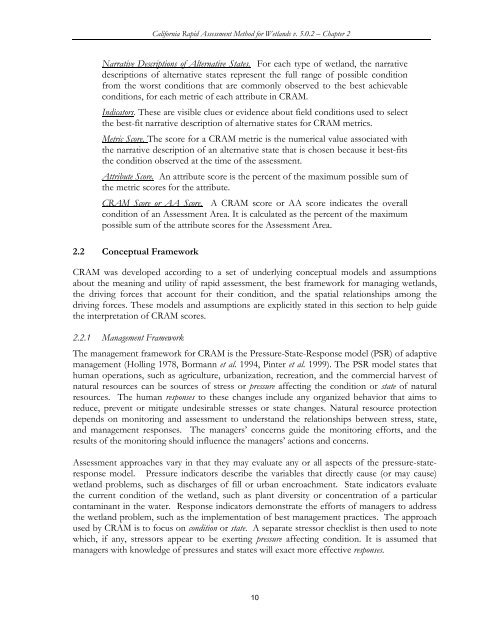California Rapid Assessment Method for Wetlands - State Water ...
California Rapid Assessment Method for Wetlands - State Water ...
California Rapid Assessment Method for Wetlands - State Water ...
Create successful ePaper yourself
Turn your PDF publications into a flip-book with our unique Google optimized e-Paper software.
<strong>Cali<strong>for</strong>nia</strong> <strong>Rapid</strong> <strong>Assessment</strong> <strong>Method</strong> <strong>for</strong> <strong>Wetlands</strong> v. 5.0.2 – Chapter 2<br />
Narrative Descriptions of Alternative <strong>State</strong>s. For each type of wetland, the narrative<br />
descriptions of alternative states represent the full range of possible condition<br />
from the worst conditions that are commonly observed to the best achievable<br />
conditions, <strong>for</strong> each metric of each attribute in CRAM.<br />
Indicators. These are visible clues or evidence about field conditions used to select<br />
the best-fit narrative description of alternative states <strong>for</strong> CRAM metrics.<br />
Metric Score. The score <strong>for</strong> a CRAM metric is the numerical value associated with<br />
the narrative description of an alternative state that is chosen because it best-fits<br />
the condition observed at the time of the assessment.<br />
Attribute Score. An attribute score is the percent of the maximum possible sum of<br />
the metric scores <strong>for</strong> the attribute.<br />
CRAM Score or AA Score. A CRAM score or AA score indicates the overall<br />
condition of an <strong>Assessment</strong> Area. It is calculated as the percent of the maximum<br />
possible sum of the attribute scores <strong>for</strong> the <strong>Assessment</strong> Area.<br />
2.2 Conceptual Framework<br />
CRAM was developed according to a set of underlying conceptual models and assumptions<br />
about the meaning and utility of rapid assessment, the best framework <strong>for</strong> managing wetlands,<br />
the driving <strong>for</strong>ces that account <strong>for</strong> their condition, and the spatial relationships among the<br />
driving <strong>for</strong>ces. These models and assumptions are explicitly stated in this section to help guide<br />
the interpretation of CRAM scores.<br />
2.2.1 Management Framework<br />
The management framework <strong>for</strong> CRAM is the Pressure-<strong>State</strong>-Response model (PSR) of adaptive<br />
management (Holling 1978, Bormann et al. 1994, Pinter et al. 1999). The PSR model states that<br />
human operations, such as agriculture, urbanization, recreation, and the commercial harvest of<br />
natural resources can be sources of stress or pressure affecting the condition or state of natural<br />
resources. The human responses to these changes include any organized behavior that aims to<br />
reduce, prevent or mitigate undesirable stresses or state changes. Natural resource protection<br />
depends on monitoring and assessment to understand the relationships between stress, state,<br />
and management responses. The managers’ concerns guide the monitoring ef<strong>for</strong>ts, and the<br />
results of the monitoring should influence the managers’ actions and concerns.<br />
<strong>Assessment</strong> approaches vary in that they may evaluate any or all aspects of the pressure-stateresponse<br />
model. Pressure indicators describe the variables that directly cause (or may cause)<br />
wetland problems, such as discharges of fill or urban encroachment. <strong>State</strong> indicators evaluate<br />
the current condition of the wetland, such as plant diversity or concentration of a particular<br />
contaminant in the water. Response indicators demonstrate the ef<strong>for</strong>ts of managers to address<br />
the wetland problem, such as the implementation of best management practices. The approach<br />
used by CRAM is to focus on condition or state. A separate stressor checklist is then used to note<br />
which, if any, stressors appear to be exerting pressure affecting condition. It is assumed that<br />
managers with knowledge of pressures and states will exact more effective responses.<br />
10















